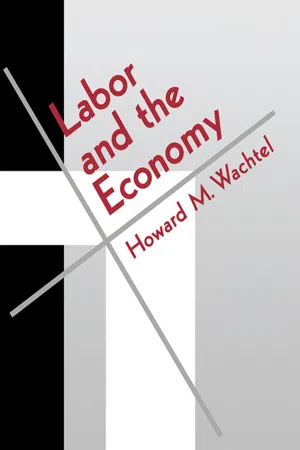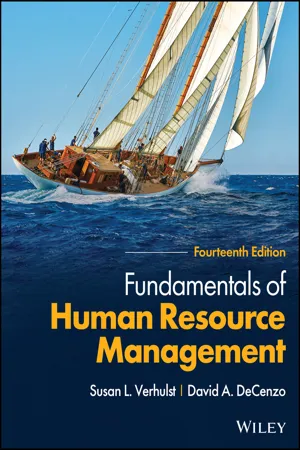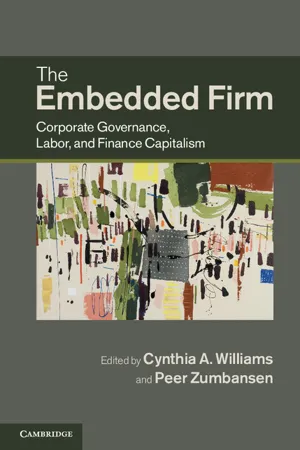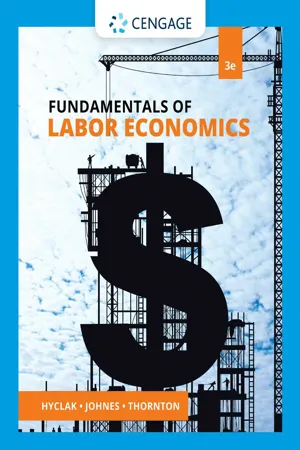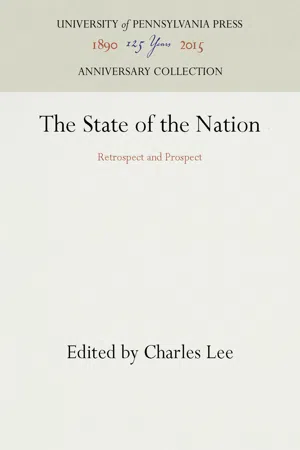Economics
Labor Unions in the US
Labor unions in the US are organizations formed by workers to protect their rights and negotiate with employers for better wages, benefits, and working conditions. They have played a significant role in shaping labor laws and regulations, and have been instrumental in advocating for workers' rights. While their influence has declined in recent decades, they continue to be a key force in the labor market.
Written by Perlego with AI-assistance
Related key terms
1 of 5
8 Key excerpts on "Labor Unions in the US"
- eBook - PDF
- David A. DeCenzo, Stephen P. Robbins(Authors)
- 2014(Publication Date)
- Wiley(Publisher)
Looking Ahead Would virtual strikes be likely to prevent or shorten strikes? Would it be easier to recruit union members if virtual strikes replaced economic strikes? 360 Chapter 14 Labor Relations and Collective Bargaining Introduction A union is an organization of workers, acting collectively, seeking to promote and protect its mutual interests through collective bargaining. However, before we can examine the activities surrounding the collective bargaining process, it is important to understand the laws that govern the labor-management relationship, what unions are, and how employees unionize. Although just under 12 percent 2 of the private sec- tor workforce is unionized, the successes and failures of organized labor’s activities affect most segments of the workforce in two important ways. 3 First, major industries in the United States—such as automobile manufacturing, communications, con- struction, as well as all branches of transportation—are unionized, and so unions have a major effect on important sectors of the economy (see Exhibit 14-1). Second, gains made by unions often spill over into other, nonunionized sectors of the economy. 4 So, the wages, hours, and working conditions of nonunion employees at a Linden, New Jersey, lumberyard may be affected by collective bargaining between the United Auto Workers and General Motors at one of the latter’s North American assembly plants. For many managers, HRM practices in a unionized organization consist chiefly of following procedures and policies laid out in the labor contract. This labor contract, agreed to by both management and the labor union, stipulates, in part, the wage rate, hours of work, and terms and conditions of employment for those covered by the negoti- ated agreement. Decisions about how to select and compensate employees, employee benefits offered, procedures for overtime, and so forth are no longer the sole decision of management for jobs that fall under the unions’ jurisdiction. - eBook - PDF
- Howard M. Wachtel(Author)
- 2013(Publication Date)
- Academic Press(Publisher)
Hhtory of Labor in the United States. 4 vols. New York: Macmillan, 1918-1935. Pelling, Henry. American Labor. Chicago: University of Chicago Press, 1960. Rayback, Joseph G. A History of American Labor. New York: Macmillan, 1963. U.S. Department of Labor. The American Worker. Washington: Government Print-ing Office, 1977. Industrial Relations in the United States Today about one-fifth of all wage and salary earners in the American economy are repre-sented by trade unions and work under collec-tive bargaining agreements. If government em-ployees are excluded from this statistic, a much higher percentage emerges as working under collective bargaining agreements in the private sector of the economy. These 20 million wage and salary earners work under contracts nego-tiated by trade unions, which are formal collec-tive bargaining agreements concluded between a recognized bargaining agent of the employees and management. These agreements are enforceable in a court of law, particularly those made in sectors that fall under the jurisdiction of the National Labor Relations Board. Wages, working conditions, fringe benefits, grievance procedures, and union 20 CHAPTER 2 0 / INDUSTRIAL RELATIONS 389 security are all issues that become codified in such agreements between labor and management. Without a collective bargaining arrangement with legal force, or a surrogate contract that exists outside this legal framework, individual em-ployees are left to their own devices to bargain over wages and protect themselves from the arbitrariness of the employer. The private government embodied in industrial relations in the modern era is an important source of protection for the worker and enhances his or her welfare. In an earlier day perhaps such bureaucratic mechanisms for adjudicating employment relations were not necessary. Moral codes had the force of law in societies dominated by religious teaching and community peer pressure. - eBook - PDF
- Susan L. Verhulst, David A. DeCenzo(Authors)
- 2021(Publication Date)
- Wiley(Publisher)
Many feel that they have outlived their usefulness in the United States, while others feel that they are still an important tool to support workers in many industries. Before we examine the attitudes and activi- ties involved in labor relations, it is important to understand the laws that govern the labor–management relationship, what unions are, and how employees union- ize. We can examine these areas by understanding both the laws that underpin labor–management relationships and why people join unions (Exhibit 14-1). Why Employees Join Unions A union is an organization of workers, acting collectively, seeking to promote and protect its mutual interests through collective bargaining. Individuals join unions for reasons as diverse as the people themselves. The most common is when a union Organization of work- ers, acting collectively, seeking to protect and promote their mutual interests through collec- tive bargaining. 0 5 10 15 20 25 30 35 40 Education, training, and library services 39.8% Government/public sector 38.4% Protective services 38.8% Transportation and utilities 18.8% Construction 13.4% Office and administrative support 10% Mining 6.6% Wholesale 5% Agriculture 1.9% EXHIBIT 14-1 Union Mem- bership by Industry Clas- sification (Selected). 3 The percentage of employees rep- resented by unions varies and is actually increasing slightly in some industries. Govern- ment and transportation workers tend to be the most likely to belong to a union. Source: U.S. Department of Labor. Why Employees Join Unions 407 contentious relationship between workers and management leads workers to find a way to have more control over their work and company policies. For others it may be pressure from coworkers, a family history of union membership, a legal require- ment, or possibly even encouragement from management because of a harmoni- ous relationship. Let’s examine some common benefits of unions that make them attractive to workers. - eBook - PDF
The Embedded Firm
Corporate Governance, Labor, and Finance Capitalism
- Cynthia A. Williams, Peer Zumbansen(Authors)
- 2011(Publication Date)
- Cambridge University Press(Publisher)
Workers in unionized enterprises generally enjoyed better wages and working conditions, greater job security, and a more equitable regimen than their counterparts in enterprises without unions. 18 But in the United States, union membership levelled off at about one-third of the non- government workforce in the 1960s, and then in subsequent decades subsided to under 10 per cent. 19 In Canada, it had reached almost 40 per cent in the 1970s and now hovers around 30 per cent, about the average for OECD countries. 20 In part, this reflects the failure of unions – especially American unions – to reach out to new constituen- cies of workers. Other factors include the inherent constraints of highly juridified systems, the inability of collective bargaining to address the complex crises of a globalizing economy, and the dissolution of labour- dominated political coalitions. 21 Mostly, however, collective bargaining in the United States did not so much expire of natural causes, as perish as a result of injuries suf- fered through aggravated assault by management. Since the 1970s, the corporate United States has waged wars of attrition to forestall union- ization, litigating endlessly to avoid complying with labour laws, block- ing legislative attempts to enhance workers’ rights, neutering labour tribunals, and introducing Human Resources (HR) policies to reduce worker discontent. 22 And while collective bargaining suffered its great- est setbacks in the United States, it is also under siege pretty much everywhere else. American attitudes and strategies have been easily exported to branch plant economies, such as Canada. 23 Other coun- tries – the United Kingdom under the Thatcher government, Australia, 18 Richard B. Freeman and James L. Medoff, What Do Unions Do? (New York: Basic Books, 1984); Paul C. Weiler, Governing the Workplace: The Future of Labor and Employment Law (Cambridge, MA: Harvard University Press, 1990). - eBook - ePub
Law and Economics
Alternative Economic Approaches to Legal and Regulatory Issues
- Margaret Oppenheimer, Nicholas Mercuro(Authors)
- 2015(Publication Date)
- Routledge(Publisher)
Part 4Legal Issues Concerning Labor, Employment, and Unemployment
9
An Alternative Economic Analysis of the Regulation of Unions and Collective Bargaining
Kenneth G. Dau-SchmidtSince the passage of the National Labor Relations Act (NLRA) in 1935, it has been the policy of American labor law to foster unionization and regulate collective bargaining for the purposes of promoting equity in bargaining power between employers and employees, and industrial peace.1 By protecting employee collective action, the framers of American labor law sought to allow employees to achieve some degree of parity with employers in the adjustment of disputes and the division of the proceeds of their labor. This system of “industrial democracy” was intended to provide employees with a greater say in the workplace and perhaps in society at large. Although strikes are a necessary evil in this process for the private resolution of grievances, the framers sought to minimize industrial strife by providing a system of elections to determine exclusive representatives, requiring “good faith” bargaining between unions and employers, and making collective bargaining agreements enforceable.This policy of fostering unions and regulating collective bargaining to promote equity and industrial peace makes no sense in the context of the traditional monopoly model of unions and collective bargaining. Under the monopoly model, unions cause inefficiency and inequity by establishing a labor cartel and prompting employers to cut production, inefficiently mix capital and labor, displace workers to unorganized markets, and raise prices to consumers.2 - eBook - PDF
- Thomas Hyclak, Geraint Johnes, Robert Thornton, , Thomas Hyclak, Thomas Hyclak, Geraint Johnes, Robert Thornton(Authors)
- 2020(Publication Date)
- Cengage Learning EMEA(Publisher)
344 Chapter 12 Unions and Collective Bargaining The Effects of Unions on Other Economic Variables Nearly all union impact studies undertaken in the United States have focused exclusively on the wage effects of unions, the reason largely being the paucity of data. But unions in both the public and the private sectors have been successful in raising the level of nonwage benefits as well. 56 By nonwage benefits (also called “fringe benefits”) we are referring to compensation in the form of vacation and holiday pay, life and health insurance, sick leave, and retirement benefits. There is evidence that union effects on fringe benefits may be proportionately greater than union effects on wages. John Budd finds that workers in union jobs receive fringe benefits that are between 15% and 40% higher than workers in similar nonunion jobs. 57 Such a finding is probably not too surprising if you think about it. As we’ve seen, in competitive labor markets in the absence of unions, firms tend to hire up to the point where the wage equals the marginal revenue product. A typical firm will thus tend to give greater weight to the marginal worker and the marginal worker’s preferences when it comes to the mix of wages and fringe benefits in the total compensation package. In a unionized situation, a union will tend to give greater weight to the preferences of the median worker (or so our median voter model predicts), who is more likely to be older and more experienced and hence more interested in nonwage benefits such as pensions, insurance, and so forth. Interestingly, Blanchflower and Freeman claim that unions in other countries seem to have had effects on nonwage outcomes that are similar in magnitude to those of US unions. 58 There is also some evidence that union effects on fringe benefits in the public sector may likewise be greater than union wage effects. - eBook - PDF
Labor Economics From A Free Market Perspective: Employing The Unemployable
Employing the Unemployable
- Walter Block(Author)
- 2008(Publication Date)
- World Scientific(Publisher)
They claim to help the underdog worker get his fair share of the economic pie with better wages, hours, and other conditions (Reynolds, 1987, p.11). Organised labour also claims to make gains for its members such as setting standards to increase workers’ levels of skill and competence, shortening the work week from seventy to forty hours, and increasing their level of health and welfare. It is important, however, to look not only at the effects of labour union poli- cies in the short-run (trees), but in the long-run as well (forest). When this ap- proach is taken, the real effects of these organisations becomes clear. Their policies distort wages and prices, curb production, decrease nonmonetary re- wards, hinder labour/management relations, and have an overall detrimental ef- fect on the economy. So who benefits from this labour agenda? The union leaders, who collect billions of dollars in dues every year from the “underdog workers” they represent. There is a very popular myth in the United States that labour unions are beneficia1 to society because of the wage “gains” received by their members. But these wage “gains” are nothing more than wage rates that are pushed above the level that a competitive free market would have brought through supply and de- mand. This is oftentimes achieved through a strike, or even the threat of a strike (Hazlitt, 1973, p.2). The strikers would like to focus attention on the plight of the so-called underpaid workers and keep the public from asking one important ques- tion - who will pay for these higher wages? The union answer is typically that the excess profits of the company involved will cover the increase. That is, the union is playing the role of a contemporary Robin Hood, taking from the rich and giving to the poor. 99 100 Volume 9 Number 1 2002 73 But the real answer is that virtually everyone pays for these higher wages in one way or another. These short-run “gains” quickly turn into long run “pains” for the entire society. - eBook - PDF
The State of the Nation
Retrospect and Prospect
- Charles Lee(Author)
- 2016(Publication Date)
This is in large part the case because of the so-called job-consciousness of the American worker. We are indebted to the late Selig Perlman for observing that in our so-called job-conscious unionism . . . the Hegelian dialectic nowhere occurs, nor is cognizance taken of 'labor's historical mission.' What monopolizes attention is labor combating competitive menaces . . . labor bargain-ing for the control of the job.' The consequent designation of our labor movement as one with limited objectives has never seemed appropriate to employers. They have particu-larly borne the brunt of labor demands and have had to make sweeping adjustments in their business way of life in order to come to terms with a formidable countervailing power. It is significant that labor unions did not initiate the current movement in the United States for governmental guides to be used in wage and price determination. And, no more than employers, do unions see any merit in the kind of national bargaining for a general wage policy that is practiced in some other democratic countries. Decentralized * Selig Perlman, A Theory of the Labor Movement, (New York : The Macmillan Company, 1928), p. viii. 114 The Role of Labor Unions private decision-making in the wage and price areas has been our way of life. It is the economists and those in the govern-mental agencies who are in the van of the national planning movement. In their own ways, they seek to express the national interests vis-à-vis those who make private decisions and to reflect an insistent public demand for protection against inflation. How can national planning needs be pro-vided for under a decentralized decision-making system in which great power resides in the private institutions? It seems to me that, in their model building, most econ-omists underrate not only the private power centers but the importance of the functions assigned to a labor union in the United States.
Index pages curate the most relevant extracts from our library of academic textbooks. They’ve been created using an in-house natural language model (NLM), each adding context and meaning to key research topics.

